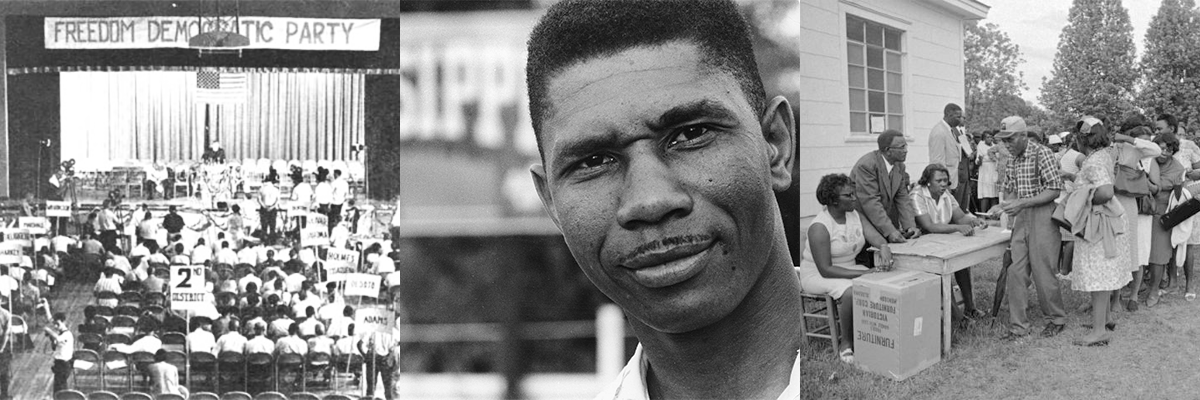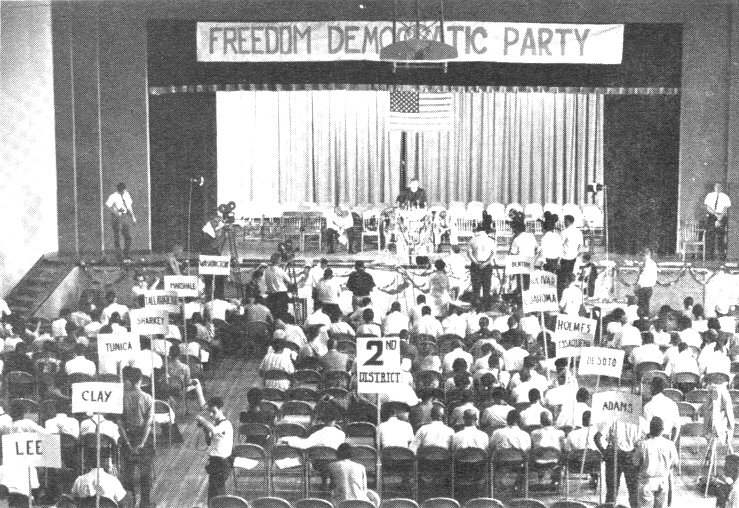
Murder of Reverend George W. Lee
Reading by Zinn Education Project
Rev. George Washington Lee, one of the first African Americans registered to vote in Humphreys County, Mississippi since Reconstruction, used his pulpit and his printing press to urge others to vote. He was murdered on May 7, 1955.

Introduction: Voting Rights
Learning the full history of the fight for voting rights is especially important today, in light of the 2013 Shelby v. Holder U.S. Supreme Court decision that struck down the 1965 Voting Rights Act provisions requiring certain states to obtain federal preclearance before changing voting laws.

Voting Rights History Quiz
Quiz by Teaching for Change
We’ve all seen the iconic image of President Lyndon Johnson signing the Voting Rights Act of 1965. But what do we know of the history that led to the signing of the legislation? This quiz can challenge assumptions, deepen understanding, and inspire further learning about the voting rights struggle.

Selma in Pictures: Socratic Seminar
Lesson by Lynda Tredway
In a media driven age, visual images often provide access to important events and political struggles that may be more immediately accessible to students than written texts. This lesson includes two sets of images from the Selma voting rights struggle that promote critical thinking by SNCC photographer Matt Herron. The steps include observation (reading the text), forming a hypothesis, and dialogue—much like an inquiry model of teaching.

Ten Things You Should Know About Selma Before You See the Film
Reading by Emilye Crosby
Key points in the history of the Selma voting rights struggle to keep in mind as you view the popular film about the Selma-to-Montgomery March.

Murder Mystery: Shining a Light on the Story That the Newspapers Left Out
Lesson by Allyson Criner Brown, Deborah Menkart, and Jenice L. View
The murder of Mississippi voting rights activist Herbert Lee, and subsequent murder of witness Louis Allen, were key events in the history of the modern Civil Rights Movement. However, they were barely mentioned in the local press at the time and the story is missing from textbooks and public memory today.

Brief Outline of the History of SNCC
Reading by Jenice L. View
SNCC is credited with many of the most innovative and effective fronts of the Civil Rights Movement. Here is a brief outline of SNCC's history.

“Is This America?” 50 Years Ago Sharecroppers Challenged Mississippi Apartheid, LBJ, and the Nation
Reading by Julian Hipkins III and Deborah Menkart
The Mississippi Freedom Democratic Party arrived at the 1965 Democratic Party Convention in Atlantic City on a bus with more than 60 sharecroppers, farmers, housewives, teachers, maids, deacons, ministers, factory workers, and small-business owners. Students can learn from the Mississippi Freedom Democratic Party about how to take on the Goliaths in politics.

Exploring the History of Freedom Schools
Lesson by Deborah Menkart and Jenice L. View
This lesson uses primary documents to introduce the history and philosophy of Freedom Schools. The lesson is inquiry-based, hands-on, and engages students in critical reflection. Therefore, students learn about Freedom Schools not only from the readings, but they also experience the pedagogy.

Literacy and Liberation
Reading by Septima P. Clark
The role of freedom schools and the Highlander Center in breaking down barriers and building leadership in the African American community.

What Would You Do? Students Grapple with Risks Faced by Voting Rights Activists
Lesson by Cristina Tosto
Students come to understand the level of bravery displayed by local activists and ordinary people in Mississippi when they simply completed a voter registration form by imagining themselves in the role of someone who lived during the modern Civil Rights Movement. The names of the activists are revealed after they’ve considered what they might do in the role they’ve been given.

Who Gets to Vote? Teaching About the Struggle for Voting Rights in the United States
Lesson by Ursula Wolfe-Rocca
Unit with three lessons on voting rights, including the history of the struggle against voter suppression in the United States.

Voting Rights Act: Beyond the Headlines
Reading by Emilye Crosby and Judy Richardson
Key points missing from most textbooks about the Voting Rights Act. Many textbooks approach the history of this important legislation through a top-down lens that gives most of the credit to President Lyndon Johnson, along with Dr. Martin Luther King Jr., but the VRA came into being through intensive organizing and activism spearheaded by the Black community.

Sheyann Webb: A Story for First Grade
Reading by Maggie Donovan
First-grade teacher and SNCC veteran Maggie Donovan wrote this story about Sheyann Webb to introduce her students to the role of young people (like themselves) in the Civil Rights Movement.

Stepping into Selma: Voting Rights History and Legacy Today
Lesson by Deborah Menkart
This lesson invites students to step into the long history of the freedom struggle in Selma, introducing them to people, turning points, and issues.

Meet Medgar Evers: Introduction to the Southern Freedom Movement
Lesson by Deborah Menkart and Jenice L. View
Medgar Wiley Evers was one of Mississippi’s most impassioned activists, orators, and visionaries for equality and against brutality. This is an interactive lesson to introduce students to his work and inspire them to learn more.

A Documents-Based Lesson on the Voting Rights Act
Lesson by Emilye Crosby
This lesson uses a case study of Lowndes County, Alabama and three SNCC-related documents from the early 1960s—just before and after the Voting Rights Act—to explore the impact of the Voting Rights Act (and 1964 Civil Rights Act) on every day southern Black citizens: What did the legislation mean to them? Did they achieve their goals?

History Detectives: Voting Rights in Mississippi, 1964
Lesson by Deborah Menkart and Jenice L. View
This lesson introduced students to the history, strategies, and challenges facing by people in Mississippi in their struggle for voting rights in the early 1960s.

Sharecroppers Challenge U.S. Apartheid
Lesson by Sara Evers, Julian Hipkins III, Deborah Menkart, and Jenice L. View
This lesson explores one of the most important events in the fight for true democracy in the U.S., when a coalition of grassroots activists challenged the Mississippi political system, the federal government, and the national Democratic Party to abide by the U.S. Constitution.

Freedom Song: Tactics for Transformation
Lesson by Alana Murray
Freedom Song is by far one of the best films for secondary students about the Civil Rights Movement. Aimed primarily at secondary students, this lesson seeks to provide students with the critical viewing skills needed to analyze the complex interplay between oppression and resistance in the Civil Rights Movement.
